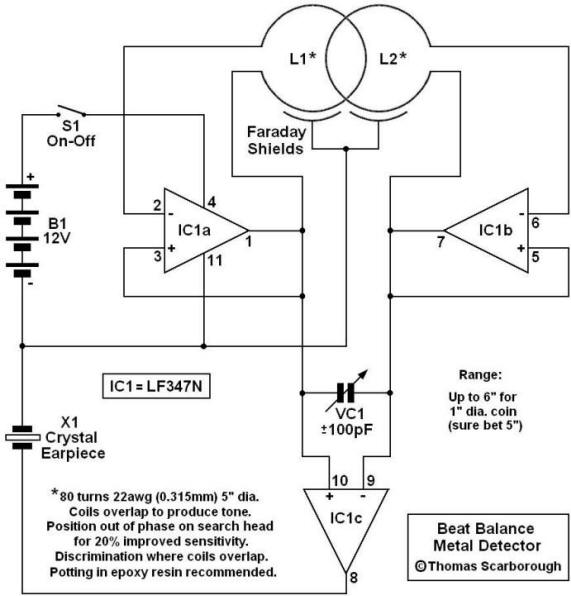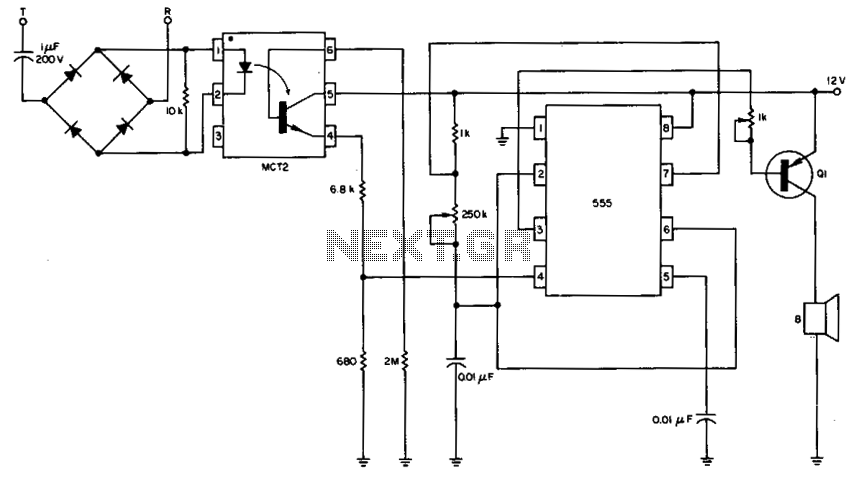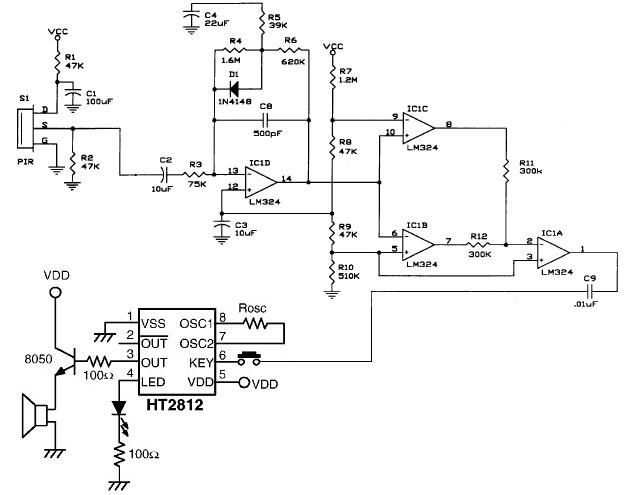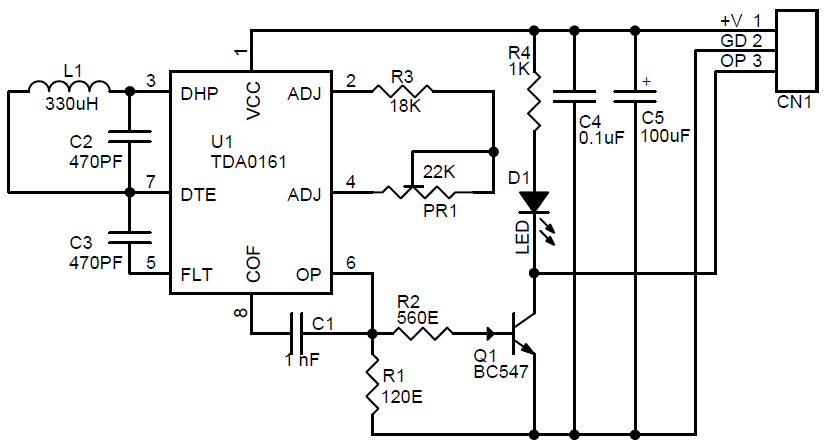
Beat Balance Metal Detector

Various embodiments of the BB metal detector have been published, and it has been widely described in the press as a new genre. Instead of using a search and a reference oscillator as with BFO, or Tx and Rx coils as with IB, it uses two transmitters or search oscillators with IB-style coil overlap. The frequencies of the two oscillators are then mixed in a similar fashion to BFO, to produce an audible heterodyne. On the surface, this design would seem to represent little more than a twinned BFO metal detector. However, what makes it different above all else, and significantly increases its range, is that each coil modifies the frequency of the adjacent oscillator through mutual coupling. This introduces the "balance" that is present in an IB metal detector and boosts sensitivity well beyond that of BFO. Since the concept borrows from both BFO and IB, it has been named a Beat Balance Metal Detector, or BB for short.
The BB metal detector represents an innovative advancement in metal detection technology by integrating principles from both Beat Frequency Oscillator (BFO) and Induction Balance (IB) systems. This device employs two transmitters or search oscillators that operate with overlapping coil configurations akin to IB designs. The mixing of frequencies from these oscillators generates an audible heterodyne signal, which is a characteristic feature of BFO systems.
A significant advantage of the BB metal detector lies in the mutual coupling effect between the coils and oscillators. This interaction allows each coil to influence the frequency of its adjacent oscillator, resulting in a balanced system that enhances sensitivity. The ability to modify oscillator frequencies through coil interaction is a defining feature that sets the BB metal detector apart from traditional BFO designs, which typically rely on a single oscillator and reference system.
The increased sensitivity and range of the BB metal detector make it particularly effective for detecting various metals, including those that are often challenging to identify with standard BFO detectors. The design's reliance on mutual coupling not only improves detection capabilities but also minimizes the impact of environmental noise, thereby providing clearer signals.
In summary, the BB metal detector is a sophisticated instrument that combines the best features of existing metal detection technologies while introducing novel elements that enhance performance. Its unique operational principles make it a valuable tool for enthusiasts and professionals alike in the field of metal detection.Various embodiments of the BB metal detector have been published, and it has been widely described in the press as a new genre. Instead of using a search and a reference oscillator as with BFO, or Tx and Rx coils as with IB, it uses two transmitters or search oscillators with IB-style coil overlap.
The frequencies of the two oscillators are then mixed in similar fashion to BFO, to produce an audible heterodyne. On the surface of it, this design would seem to represent little more than a twinned BFO metal detector. However, what makes it different above all else, and significantly increases its range, is that each coil modifies the frequency of the adjacent oscillator through mutual coupling.
This introduces the "balance" that is present in an IB metal detector, and boosts sensitivity well beyond that of BFO. Since the concept borrows from both BFO and IB, I have given a nod to each of these by naming it a Beat Balance Metal Detector, or BB for short.
Happy hunting! 🔗 External reference
The BB metal detector represents an innovative advancement in metal detection technology by integrating principles from both Beat Frequency Oscillator (BFO) and Induction Balance (IB) systems. This device employs two transmitters or search oscillators that operate with overlapping coil configurations akin to IB designs. The mixing of frequencies from these oscillators generates an audible heterodyne signal, which is a characteristic feature of BFO systems.
A significant advantage of the BB metal detector lies in the mutual coupling effect between the coils and oscillators. This interaction allows each coil to influence the frequency of its adjacent oscillator, resulting in a balanced system that enhances sensitivity. The ability to modify oscillator frequencies through coil interaction is a defining feature that sets the BB metal detector apart from traditional BFO designs, which typically rely on a single oscillator and reference system.
The increased sensitivity and range of the BB metal detector make it particularly effective for detecting various metals, including those that are often challenging to identify with standard BFO detectors. The design's reliance on mutual coupling not only improves detection capabilities but also minimizes the impact of environmental noise, thereby providing clearer signals.
In summary, the BB metal detector is a sophisticated instrument that combines the best features of existing metal detection technologies while introducing novel elements that enhance performance. Its unique operational principles make it a valuable tool for enthusiasts and professionals alike in the field of metal detection.Various embodiments of the BB metal detector have been published, and it has been widely described in the press as a new genre. Instead of using a search and a reference oscillator as with BFO, or Tx and Rx coils as with IB, it uses two transmitters or search oscillators with IB-style coil overlap.
The frequencies of the two oscillators are then mixed in similar fashion to BFO, to produce an audible heterodyne. On the surface of it, this design would seem to represent little more than a twinned BFO metal detector. However, what makes it different above all else, and significantly increases its range, is that each coil modifies the frequency of the adjacent oscillator through mutual coupling.
This introduces the "balance" that is present in an IB metal detector, and boosts sensitivity well beyond that of BFO. Since the concept borrows from both BFO and IB, I have given a nod to each of these by naming it a Beat Balance Metal Detector, or BB for short.
Happy hunting! 🔗 External reference





